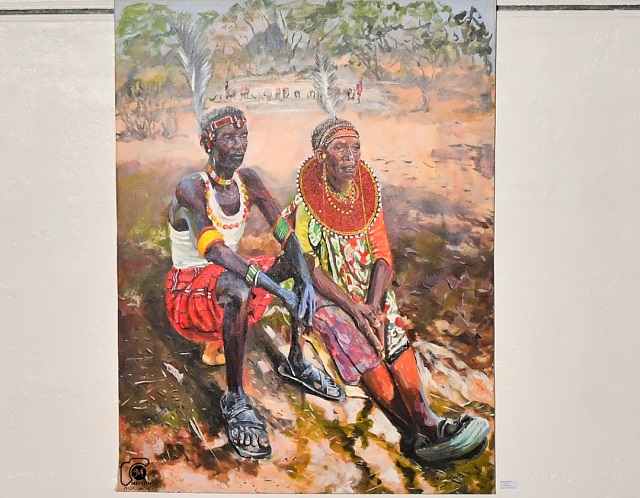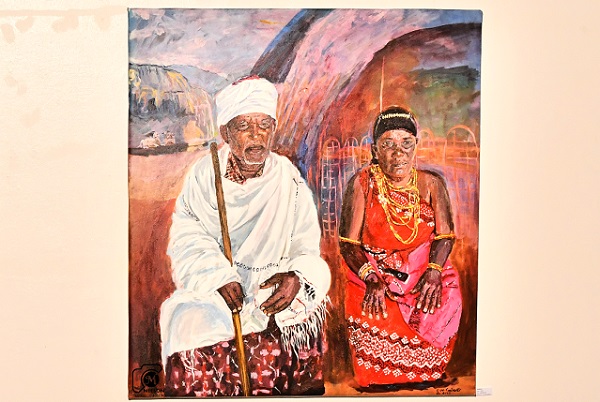
Senior artist, celebrates East African cultural heritage on canvas while showcasing his ingenuity with working with stain glass as a material that references a rich cultural heritage from medieval European art
ART | DOMINIC MUWANGUZI | What immediately captures your attention at the Makerere Art gallery now as you make your way inside the gallery, is the white banner with the image of the black Jesus with a crown of thorns. It is an intriguing image; not necessarily because it depicts an unusual composition, a reminder to one of Francis Musango’s suggestive and explosive paintings in the series art rooted in Christianity; but the use of colour which is pure after thorough observation of the image on the poster. Once inside the gallery, you’re again greeted with portraits of subjects from different parts of the continent. These artworks seem to suggest a vast and intensive study of the cultures of these grouping of people evident with the social and economic livelihood that surrounds them. It is upon this exploratory pursuit that the name of the exhibition My Heritage by Leonard Kateete is hatched.
Through our conversation about the exhibition, the artist easily concedes to his deep relationship with different cultures of the East African region. The influence, perhaps inadvertently stems from his “migration” to Kenya as a young man in 1980 immediately after graduating from Makerere art school. This may have contributed to his assimilation into an East African citizen and not a Ugandan in exile per se. But to be exact, it is the experience he had with the different ethnic groups across the region under an art grant that was extended to him in 1995, that significantly impacted his outlook to cultural heritage as a form of identity and therefore needs to be conserved through the visual arts. In this, Kateete’s work strongly pays homage to the theme of identity and social wellbeing. Take for example, The Way of the Cross which is exceptionally executed with the artist placing the story of Jesus’s suffering in the context of our day-to-day living. For each station of the cross, the artist creates a visual representation of this particular moment in Christ’s suffering that is familiar to the challenges encountered by the ordinary people.

While the artist excels in painting, it is sculpture art that is definitely his forte like showcased in a documentary showing on a large screen in one part of the gallery. In the documentary, the audience get to interact with the artist’s commissioned large scale sculptural works in different catholic churches across in Kenya and Tanzania. From the mosaic mural of the Holy Family to the Virgin Mother’s Immaculate Conception, the artist exhibits immense expertise in working with stained glass and mosaic as a delicate but complex material. Yet this medium in his art, also seems to be is a rejoinder to the subject of heritage conservation that runs through his work. Stained glass has been used for centuries in the beautification of churches and construction of Christian art. In ancient Egypt and Rome, the tradition of working with the glass material was common and today is suggested by art historians as one of the oldest mediums used to make art.
But the most fascinating aspect of working with stained glass is it facilitates experimentation of the effect of light and darkness on colour. As such, the mural paintings from a distance have an astonishing impact on the eye of the viewer almost engulfing them with their dreamy appearance. Equally, the paintings washed in pure colours of red, blue, green and orange are loaded with emotions that the viewer does not tire from looking at them. If there is anything that we can learn from Kateete is expressive work, especially the portraits, is that there is power in be simplicity.
This exhibition like many that are mounted at the gallery, is a thoughtful showcase of art that feeds into one of the functions of this institution as a centre for heritage conservation and restoration. Through the showcase of these images, the artist deeply wants to communicate the commonality of different ethnic groups within the East African region. Despite the artificial boundaries created by colonialism, we’re one people emphasized by the delicate similarity in our dialect and traditional customs. Such oneness is very well appreciated, documented and preserved in this classic visual representation.
The exhibition ‘My Heritage’ is showing at Makerere art gallery, located within the campus of Margret Trowell School of Industrial and Fine art Makerere.
The post Leonard Kateete’s Homecoming solo show appeared first on The Independent Uganda:.



